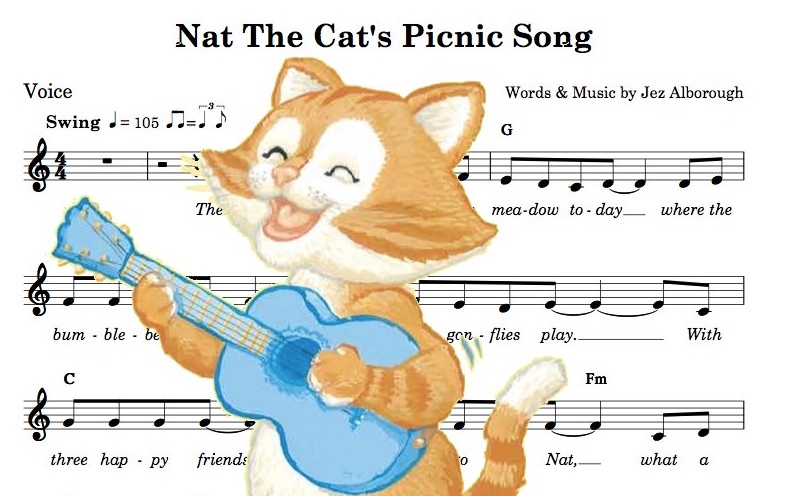CHILDREN'S BOOKS

Nat the Cat, the heroine of my new picture book series, is a feline troubadour who never goes anywhere without her trusty blue guitar. This means that she is able to embellish the end of her book with a song about the events which happen in the story, rather like finishing a musical on a show-stopping song.
I’ve often heard it said that characters in picture books are all versions of the writer’s own psyche. Well I do play guitar and compose songs so perhaps there is some truth in this. Until Nat came along I had never married my love of music with my day job of writing picture books before. You might think that these two creative jobs are pretty similar and that all I have to do is pull out some lines from the rhyming text, come up with a tune and out comes a song. Unfortunately it’s not quite as easy as that. There are a number of factors which make writing a song quite a different experience to writing a rhyming text. The song has to work within the story as part of the text while functioning as a stand alone song at the same time. Also, because it appears as part of the text it has to be a very short. I set myself the limit of only eight lines, any more than that and the song would interrupt the flow of the story. As ever with the creative process, limitations like these can help to focus the mind. It provides you with a strict discipline in the same way that in writing picture books you only have thirty two pages to tell your story.
Writing a song does have some parallels with creating a picture book; one uses lyrics and music to tell a story while the other uses text and illustrations. In each case the words have a partner to support, embellish and give them context. In songs you could say the tools we use to do this are melody and rhythm whereas picture books use colour and shapes.
I started Nat’s song by writing the lyrics. Some lines just sound like a line from a song and when I came up with this couplet I knew I was onto something.
‘There’s a picnic down in the meadow today,
where the bumblebees buzz and the dragonflies play.’
After ‘catching’ the other six lines the next challenge was to create a memorable melody to go with the rhythm of the song. By following my intuition and trying out various possibilities, line by line Nat’s song gradually emerged. I was searching for something which sounded so ‘right’ that it almost seemed familiar, as if I’d heard it before. Next the tune in my head had to be written down and ‘caught’ on paper. Although I’ve been playing and making up music for decades I never learnt to read it properly so I had to sing the notes, work out what they are on my guitar and then write them as a letter above the lyrics.
When I was satisfied that the tune was fully formed I played it and showed my musical scribbles to a musician friend who turned it into the notation language that ‘proper’ musicians can understand with notes, time signatures etc. This was quite a magical moment because it seemed that the lyrics and melody which I’d come up with had finally become a real little song; I called it 'Nat the Cat’s Picnic Song'. You can hear me singing and playing it here.
I’m hoping that you’ll find the inclusion of this song adds something extra to Nat’s story. If you are musical then you can play the song from the notation in the book (this, along with a tablature version for guitar is also downloadable from my site). If like me you don’t read music, feel free to make up your own tune! Happy singing…
This article originally appeared on the BookTrust website.
NEW ON THE SITE
HAVE YOU SEEN?













